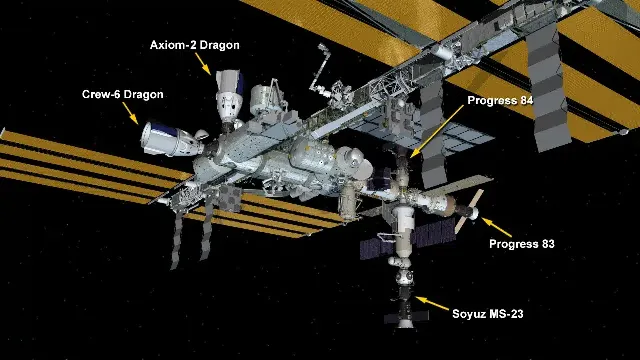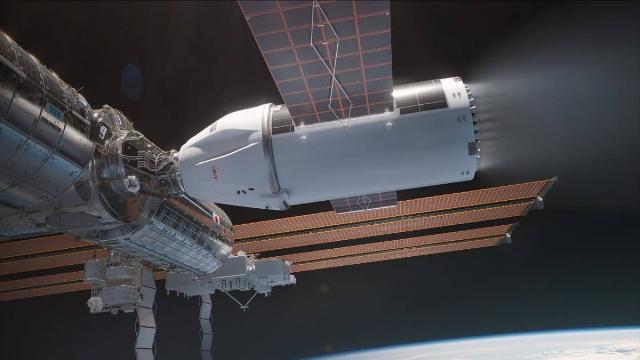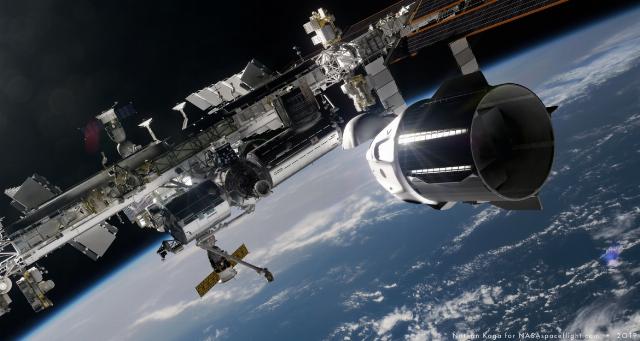According to updated data, Elon Musk's company uses a heavily modified cargo ship with a record number of engines (more than any other ship in history) to launch the International Space Station from orbit. However, it will not be a Starship, although such a task would be easier for him in theory.
The ISS is nearing the end of its useful life: in addition to the typical biofouling problems for space stations, air leaks occur periodically in the Russian segment, caused, among other things, by fatigue cracks in metal, which will accumulate over time. In this regard, the National Aeronautics and Space Administration of the United States plans to light the station from orbit.
According to new data from NASA, in theory such a code can be implemented with the help of Russian Progress trucks. However, for well-controlled information from orbit, according to the American side, it would take three pieces at once, and the Russian segment of the station cannot accept so much.
Therefore, the US Space Agency decided to pay SpaceX $ 843 million to bring down the station with its funds — around 2031. To do this, use the Dragon cargo ship. Instead of the standard 18 Draco engines (powered by monomethylhydrazine and nitrogen tetraoxide), it will have 46 such engines and carry 16 tons of fuel. This is a record number: no modern spacecraft or rocket has so many engines. Dragon will have to be seriously modified: according to NASA estimates, it will be about half "new". The service compartment in which goods are transported will be much longer.

It is easy to see that up to four cargo ships (a pair of Progress Rv and a pair of Dragon) can be docked to the ISS. In this case, why do you need to design a special ship to bring the ISS down from orbit? Perhaps the fact is that several missions to take down the ISS with conventional cargo ships would cost more than creating one specialized one for 843 million. NASA, however, does not gravitate towards cheaper solutions
Image source: Wikimedia Commons
In addition, the ship will be significantly heavier than modern ones, which is why it will not be possible to launch it into space on a Falcon 9 rocket, as is the case with SpaceX ships today. They use another carrier — perhaps a Falcon Heavy or Starship.
The enlarged "truck" will be put into orbit a year and a half before the ISS is flooded in the South Pacific or Indian Ocean. For about a year, it will smoothly slow down the station, thereby gradually lowering the altitude of its orbit.

SpaceX sees the new elongated Dragon exactly like this
Image source: SpaceX
During this time, the astronauts will remain on board the station. Six months before the sinking, the ship will reduce its orbit to 220 kilometers (now about 420 kilometers). As soon as the mark of 220 kilometers is reached, the descent will go faster, and four days after it, the station will descend from orbit.
Despite the fall and partial combustion in the atmosphere, according to NASA calculations, sufficiently large fragments — the maximum size of a car — will reach the surface of our planet. That is why, according to the agency, a special expensive and long-term mission for controlled information is needed.
At the same time, there are a number of questions about the mission. For example, in 1979, NASA brought down from orbit a large (with the volume of the future "Mir") Skylab orbital station without any ships at all. The United States then stopped flying Saturns so that there would be enough money to work out another, dead-end carrier. But with its development, by the time the Skylab descended, they did not have time, so the station was braked about the atmosphere only with the help of its low-power maneuvering engines. Despite this, the bulk of it fell into the Indian Ocean, with only some debris reaching sparsely populated regions of Australia.
Even more doubtful is the statement by NASA representatives that it would take three "Advances" to inform the ISS. Such a large station as Mir was very safely taken out of orbit in 2001, using only one Progress. The ISS is larger than Mir, but it can be undocked and flooded by a pair of Progress and an ordinary Dragon in parts — that is, in theory, it does not need to involve any new, specially and deeply modified ships of American performers. A pair of long-established and serial "Progresses" or Dragon are worth much less than $ 843 million.
Obviously, the true reasons for the entire operation are that NASA, for political reasons, does not want to seek help from Roscosmos. The question remains unanswered as to why a modified Dragon was chosen for this task instead of the usual Starship, which by 2031 will clearly be serial and fully worked out.

